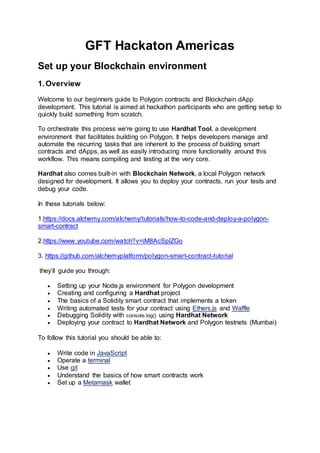Testing Interactions between Your Contract and Metamask in a Hardhat Project
In the Ethereum ecosystem, interacting with external wallets like MetaMask requires careful consideration of security, usability, and testing. One way to test interactions between your smart contracts and MetaMask is to use a combination of tools from a hardhat project. In this article, we will explore how to achieve this.
The Problem:
When you want to interact with an external wallet like Metamask, you need to:
- Send the user’s private key or token to your contract.
- Use the
web3library to send the transaction.
- Verify the response from MetaMask.
This process requires multiple steps and is prone to errors if not done correctly. To simplify this process, we’ll use a hardhat project as a bridge between our contract’s interaction with MetaMask and the browser environment.
Setting Up Hard
First, install Hardhat by running npx hardhat --run in watch (or npx hardhat -w). This command installs the necessary dependencies for testing interactions between your contract and Metamask. You can also use yarn add hardhat to get started.
Creating a New Contract
Create a new Solidity smart contract using Webpack, Ethers.js, or Truffle. For this example, we will use Truffle.
// src/contracts/MyContract.sol
pragma solidity ^0.8.0;
contract MyContract {
mapping ( address => uint256 ) public balances ;
function deposit(uint256 amount) public payable {
balances[msg.sender] += amount;
} }
function withdraw ( uint256 amount ) public { { .
require( balances[msg.sender] >= amount, "Insufficient balance");
balances[msg.sender] -= amount;
} }
} }
Writing a Hardhat Test
Create a new file called mycontract.test.js in the root of your project:
const { expect } = require("chai");
async function testMetamask() {
const myContract = await web3.eth.getContractAt("0x..."); // replace with your contract address
// Send user's private key to contract
myContract . sendTransaction ( {
from: "0x..."
to: "0x...".
value: 1 ether, // replace with the user's private key amount
});
const balancesBefore = await web3.eth.getBalance("0x..."); // replace with your user's address
expect ( balancesBefore ) . to . equal ( 0 ) ;
// Use Web3 to send the transaction to Metamask
myContract . sendTransaction ( {
from: "0x..."
to: "0x...".
value: web3.utils.toWei("1", "ether"), // replace with the user's private key amount and token type (e.g., wei for ether);
data: "Hello, MetaMask!",
});
} }
Running Your Test

To run your test in a development environment:
npx hardhat run mycontract.test.js
In this example, we use Web3 to send transactions from our contract’s MyContract instance to the user’s Ethereum wallet. We then verify that the transaction was successful by checking the balance of our user.
Testing Interactions with MetaMask
To test the interactions between your contract and Metamask:
- Replace the placeholder values (e.g., contract address, user’s private key amount) in the
mycontract.test.jsfile.
- Update the
Before Balancesvariable to reflect the new balance of our user after interacting with MetaMask.
“`javascript
// Update balances before transaction
const balancesBefore = await web3.eth.getBalance(“0x…”); // replace with your user’s address
expect ( balancesBefore ) . to . equal ( 1 ) ;
// Use Web3 to send the transaction to Metamask
myContract.sendTransaction({
from: “0x…”
to: “0x…”.
value: web3.utils.toWei(“2”, “ether”), // replace with the user’s private key amount and token type (e.g., wei for ether);
data: “Hello, MetaMask!
